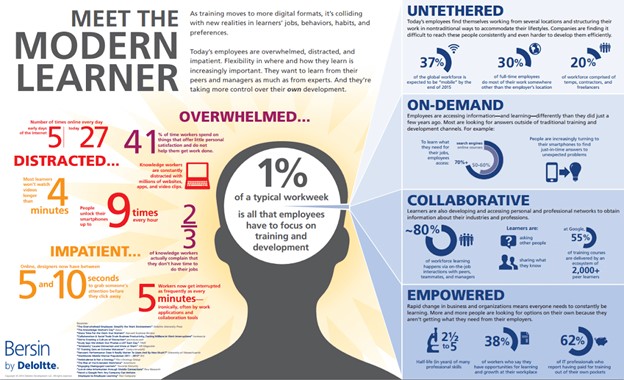What Challenges Does the Modern Learner Face?
Shauna Carson
Last week, we discussed using strategies like gamification and multimedia to engage your learners. Now it's time to turn the focus to the foundation of learner engagement. When you align your goals and give learners what they need in a format that works for them, they'll seek you out.
Today, we'll look at the challenges modern learners face, how those challenges shape their approach to learning, and how organizations can respond to their needs.
Who is the modern learner?
The best description of the modern learner I've found is this infographic by Bersin by Deloitte:

Although the infographic is a few years old, its conclusions still stand. The modern learner is overwhelmed, distracted, impatient, untethered, on-demand, collaborative and empowered. But what do these adjectives reveal about the challenges faced by modern learners and how L&D can partner in tackling them?
The Modern Learner's Challenges
1. Finding Time for Learning
The modern learner is motivated to learn but struggles to find the time. Employees have an average of about 20 minutes a week to dedicate to training and development. Two-thirds of them say they don't have enough time to do their jobs, let alone take on additional training.
They therefore need learning that is:
- Delivered in short, discrete segments.
Many eLearning modules and every seminar and classroom learning event I've experienced has taken more than 20 minutes. Microlearning, learning delivered in short, to-the-point portions that can be completed in the time available, is the obvious response to this challenge.
- Supported by organizational culture and policies.
Microlearning isn't the answer to everything. Complex topics can be hard to follow when broken apart. When longer modules or seminars are indicated, it's vital to offer organizational support. Dedicating time for learning and providing job coverage during scheduled learning events can make learning more accessible to the modern learner.
- Directly relevant to their jobs.
One way to convince the modern learner to spend precious time on learning is to make it directly relevant to their jobs. If you want them to take time off work to learn, that learning should show them how to do their work faster or more effectively.
- Offers personal, non-job-specific benefits.
Alternatively, learning can offer personal benefits beyond the job that are attractive enough for learners to undertake the learning in their own time. Soft skills are currently of particular interest to many employees.
2. Coping with Distractions and Impatience
Workplaces are busy places. With workers frequently interrupted by others (and interrupting themselves to check their phones up to nine times an hour), learning material must catch their attention quickly. It must also either get the point across within the few minutes learners devote to it or hold enough interest to bring them back after a disruption.
Effective L&D responses to distractions are similar to the responses to lack of time:
- Microlearning
Brief learning elements that can be completed between distractions appeal to the modern learner. And brief really means brief. In the case of video, there is a significant drop-off in engagement after just two minutes.
- Classroom learning
One response to distraction is to remove the learner from the distraction. As suggested above, this strategy is only likely to be successful with organizational support.
- Job-relevance
Once again, relevance can be key to catching a learner's attention. And on-job applicability must be obvious from the outset. If links are hidden in the course material, learners won't stick around long enough to find them. Current research indicates that you have seven seconds to convince a learner to stick with your learning material.
3. Working Away from the Office
Almost a third of workers complete the bulk of their work somewhere other than their employer's office. That doesn't necessarily mean in a home office with access to a VPN, either. Training is highly mobile and takes place anytime, anywhere. Consider these statistics:
- 27% of learners learn while commuting to and from work
- 47% learn on the evenings and weekends
- 70% use their smartphones to learn
To meet the needs of today's learners, learning material has to be:
- Mobile
Mobile learning is learning delivered on a phone or tablet. Many systems now optimize online content delivery for different devices, but there's more to good mobile learning than responsive design. While any online material can be delivered to a phone, does the smaller screen let learners see the detail they need on a diagram or video? Learn more about the specific issues and design concerns of mobile learning in Benefits and Challenges of Mobile Learning.
- Short
Yes, we're back to microlearning again. Few learners are willing to click (or tap) their way through a two-hour module on their phones. Mobile learning is instant, in the moment and on-demand. Learners pick up their phones to check a fact, procedure or policy, not usually for deeper learning.
- Searchable
And if phones are used for quick checks or updates, that material must be easy to find. In an on-demand world, it's becoming increasingly important for learning material to be searchable.
4. Changing Job Requirements
Pamela Hogle says that "[d]ue to the rapid pace of change in what work looks like, what technologies employees need to master, and what skills they need, everyone has become a lifelong learner." And workers know it. They expect to receive the training they need, when they need it. To meet their needs, training must be:
- Up-to-date
As technologies and job requirements change, the learning material that will help employees keep up with requirements changes. L&D departments must be on top of these developments to remain relevant.
- Of value to the learner
Evolving roles and technologies contribute to the time pressures discussed earlier. Modern employees have so many things demanding their attention that they must choose only the most valuable. Any learning material that isn't of evident value won't be selected.
Approach to Learning
Bersin by Deloitte also described the modern learner as 'empowered'. When their strong desire and need to learn is combined with the challenges outlined here, the result is a learner who will find a way to learn what they need. Faced with a question they can't answer, the modern employee picks up their phone to look for the answer - and if you don't provide learning in a style and manner that suits them, they'll find it somewhere else. Such initiative is an excellent trait. At the same time, most organizations would prefer to have some influence over what their employees are learning, especially in regard to job tasks. Organizations can only maintain that influence by becoming the resource of choice. Offer the best resources in a useful and valuable way, and your employees will seek you out.
Conclusion
Modern learners face many challenges, including time pressures, distractions, distance from office infrastructure and rapidly developing demands. It's easy for learning opportunities to be lost in the maelstrom. Yet learners remain eager for training: interested in material that will help them meet the demands of the moment and in developing soft skills they can rely on in the future. Employers can best help their employees and themselves by providing learning on the subjects and in the formats that provide the most value to the modern learner.
📘 Ready to Elevate Your Learning Strategy?
Explore our comprehensive library of eBooks and tools on learning resource development, competency-based learning, and LMS implementation. Transform your training programs with insights from industry experts and practical templates.
Shauna Carson
Shauna graduated from the University of Toronto in 2002 with a Master of Arts in English before moving home to Calgary to work in the fast-paced, detail-oriented oil and gas industry. Now certified as a technical writer, Shauna is comfortable writing in a variety of styles, and for a variety of audiences.
